#rph guides
Text
How to Get a Chronological Dash as a New Blog
I've been working on a Tumblr Roleplaying 101 guide, and in doing so wound up making a brand new Tumblr account for some screenshots. And this process made me realize how weirdly complicated Tumblr has made it for new accounts to get a chronological dash. So if you just want to see posts from people you follow, in the order that they made them, this what you have to do.
First, go to your settings, go under Dashboard, and scroll down to Preferences. Toggle off Best Stuff First. This switches your dash from an algorithm feed to a chronological one.

If you have an older blog, that's all you have to do. But if your blog was created more recently, you have an extra step.
The Tumblr dashboard has different tabs, which you can see across the top of your feed. Most older users have completed tuned these out, because we don't care about anything other than the basic feed. There is a Following tab, which shows posts from users you follow, and a For you tab, which shows recommend posts Tumblr thinks you'll like.

On blogs created before May 8, 2023, the Following tab is the default view. However, blogs created after this date have the For you tab as the default view. (This is an intentional change by Tumblr.)

This means if you are a newer blog and want to see posts from people you follow, you'll need to manually switch to the Following tab every time you open the dashboard.
If you do not like this change, consider contacting Tumblr staff. Submit a form under the Feedback category and explain that you'd like the option to make the Following tab the default for new blogs. And please, be polite! There is a person on the other side of the screen who likely had no say in this change, and even if they did, they don't deserve to be yelled at.
6K notes
·
View notes
Text

⠀⠀⠀𝐇𝐎𝐖 𝐓𝐎 𝐂𝐑𝐄𝐀𝐓𝐄 𝐀 𝐆𝐎𝐎𝐃 𝐕𝐈𝐋𝐋𝐀𝐈𝐍 𝐈𝐍 𝐑𝐏.
⠀⠀⠀Anyone who knows me or has rp with me knows how much I love building ambiguous — or grey, if you prefer — characters or villains. The drama, the chaos, the complex plot… It all makes everything more interesting, especially once you get bored of characters who are exclusively nice, naive and suchlike. Even so, it's a construction that needs to take several factors into account and be very delicately written so it doesn't become a trigger rather than a character.
⠀⠀⠀For this reason, below I've provided some tips on how to create villainous characters for rp, taking into account various traits, setting and also demystifying the fact that not every villain is a soulless monster. Anyway, on to the guide.

Deep and personal motivations.
⠀⠀⠀Convincing villains usually have compelling and understandable motivations, even if their actions are highly questionable. It's the premise of them being right in their quest, but using the wrong means to achieve it and ultimately losing their reason. This brings a sense of humanity and it's even possible to feel connected to what led this person to become a villain. You can truly see how they lost the way.
⠀⠀⠀Another point is the fact that not everyone wants to conquer the world, nor do they have the ambition to have a lot of money or power. Think of plots about revenge, twisted love, the quest for justice or fear. Generally, a character's deepest motivations give them more determination to fulfill their goals because it comes from something much more internal and traumatic. Give them a proper reason and make them lose the way, this is gonna make everything feel real, convincing and interesting to developed.
Moral complexity.
⠀⠀⠀The simple truth is the days of people liking completely cartoonish characters are long gone, and nowadays many people don't like those who are evil simply for the sake of being evil. This is because it's too out of touch with reality. Obviously there are people who are like that in real life, but the vast majority is more complex than this. Humans, in the end, are very complicated and, probably, will never truly understand why we are the way we are.
⠀⠀⠀To get away of this cliché and cartoonish form when creating your character, try to develop moral nuances and internal dilemmas which can explain their actions. Put a small fragment of morality in the character, make them question themselves a few times as to whether they're on the right path… Remember yin yang: there's a little tiny good inside the evil. This tip can be used for any character, when you think about it, but it's very important for those who want to create villains.
Human traits, personality and vulnerabilities.
⠀⠀⠀Like any human being, provide your character with traits unmistakably human, such as fears, insecurities or personal relationships that will impact them, to make them more realistic. Just because someone is doing something morally wrong doesn't mean they've lost all touch with their humanity, especially since not every villain is a psychopath who has no empathy for anyone. It's always very interesting when a character believes they're doing what's right or good for someone else, and this is their motivation.
⠀⠀⠀Also bring some weaknesses to the character, whether physical, emotional or psychological. This provides room for development and also ways for other characters to access them in a more specific way, either to get to know them better or to retaliate against them at some point.
⠀⠀⠀You know that line "Do you like my personality? I created it especially for you!"? Well, consider how the character behaves and bring in more layers when making the personality. Take into account how they behave in different situations and with different people.
Charisma and a magnetic nature.
⠀⠀⠀The fact is that bad guys aren't unbearable one hundred per cent of the time, they need to know how to live in society and captivate people. So define unique and appealing traits for the character, whether they're genuine or merely a façade. It's always interesting when, within the plot, most people don't know about the evil or wrong side of a character because it gives them more room for development. Maybe make them ashamed of what they're doing and try to hide it as best they can. And just think about real life: do we truly know the people around us?
Connection with other characters.
⠀⠀⠀Nobody lives completely alone since we're in a society and this makes us having connections, for more simple they can be. Thinking about that, create connections with other characters to bring more motivation and drama to your muse, such as an old rivalry, a complicated personal relationship or a surprising connection which generates tension. You can also create connections that actually bring their good side to light, you know? It's also always good to add a certain complexity, to have troubled moments, wounds that haven't healed fully, secrets being revelead, etc.
Questions for creating villains.
What are the character's main motivations?
What is the character's origin story? What led them to become what they are today?
What are the past traumas or events that have shaped their worldview?
How does the character justify their actions morally? Does they believe they are doing the right thing?
What are their weaknesses and vulnerabilities?
How does the character present themselves to the world? Are they masked, manipulative or showy?
What do they want to achieve through their actions?
What are their emotional reactions to obstacles and challenges?
How do they justify their actions to themselves? Is there any sense of internal validation?
How do they relate to the authorities or the law?
How do they see themselves? Do they see themselves as the hero of their own story?
How do they react when their plans fail?
What do they feel when faced with the possibility of redemption or change?
Other small (and important) advice!
Corruption arcs are also super interesting, leading a good character to become bad over time and through traumatic situations. Redemption arcs are also sensational. The point is: nobody was born a villain and nobody has to die a villain.
Leave clues indicating your character before fully revealing your motivations. Also try to leave some motivations completely secret, using them when the plot calls for a surprise. In the best "surprise, bitch!" style.
Think about how environment and culture can influence beliefs and actions.
A villain doesn't have to be a psychopath or murderer. There are arcs of revenge and corruption which can be created without going to such extremes.
It's obvious, but always respect other players and the limits they impose. As I said, a villain isn't always doing evil and being a complete asshole, so make sure you know what kind of approach the other person will prefer.
Always be careful when approaching topics which are triggers and avoid them as much as possible. As I said, it's not necessary to go down this route, but if you do, always keep a firm grounding when writing, because triggers are complex real-life situations that always need to be handled delicately.
The end, for now.

( Be with Morgana, my good girl gone bad ♡ )
#rph#rp help#rp resources#rp writing help#writing resources#writing help#writing advice#writingtips#rp guide
284 notes
·
View notes
Text
TIPS FOR WRITING COMBAT, TACTICS, AND / OR FIELD MEDICINE SCENARIOS
Saw a post that made me think about this, so I wanted to share some resources and online profiles I had around writing things such as combat, tactical operations, and / or field medicine! Plus my Call of Duty fixation is in full swing fjslfjdslfj
Disclaimer: I am not a medical professional, nor am I someone who has served in the military or law enforcement in any capacity. Some topics may be unsettling/disturbing, so please take care in reading.
This isn't as organized as I'd like it to be, but I did my best to make it fairly easy to navigate.
Doc Combat [TikTok] - A collection of videos focused around administering Tactical Combat Casualty Care (TCCC).
Tactical Combat Casualty Care Quick Reference Guide, First Edition (2017) [PDF] - A handbook published by the U.S. Government and military detailing basic management, what to do in scenarios, and how to address varying types of wounds.
Protocols for Common Injuries from Police Weapons [Archive] - A guide detailing various injuries that can be collected from police/military weapons and how to attend to them.
Organizing Armed Defense in America [Archive] - A guide on how to establish security and defense measures, as well as a list of equipment often used in militia groups.
FEMA Independent Study Courses [Website] - An extensive collection of free (yes, free) courses provided by the Federal Emergency Management Agency, which covers so many topics, such as Hazardous Materials, Active Shooting, Community Emergency Response, Fire Safety, and more! You can save any information provided in the course(s) you choose, as it's all public access.
Writing (US) Government Clearances [Tumblr] - A small guide on how to navigate government clearances.
TM 31-210 Improvised Munitions Handbook [Archive] - Pretty self-explanatory, but an archive of documents showing how improvised munitions are made.
The US Military Manual Collection [Archive] - A collection of US manuals published by the United States Army's Army Publishing Directorate.
Remember, all of this information is publicly accessible! I seriously cannot recommend using archival websites enough, especially since Google (and other search engines) manipulate what appears first with every search.
Also, I am not responsible for what y'all do with this info. Read responsibly, and stay frosty!
167 notes
·
View notes
Text

✦ Okay, I give in. Let's upload our gifs on the beta editor to prepare for a gif pack page. Resources are available at the bottom, so lets get started !!
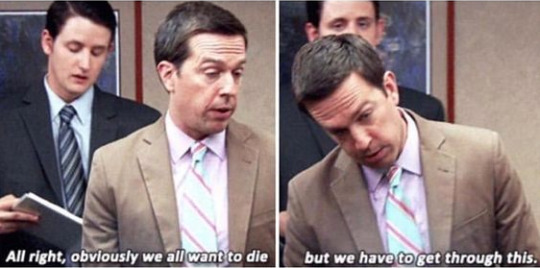
So first things first, you can only upload 30 gifs at a time. Now for me, I will always upload as I gif, around every 20 gifs, then upload to the page (this also ensures I don't skip any or have doubles) and keep gifing. That used to mean that I don't have to wait for tumblr to load 300 gifs and die from impatience. For the rest of y'all that means you're going to have to batch upload. I know, I'm sorry.
Note: With the help of @nataliealynlind we discovered that the daily limit is 250 gifs! So if you have more than that, prepare to upload your gifs over the course of a couple days or use a second blog. (imo this is another great reason to upload as you gif! that way you don't have to get stuck at 250!)

So after you upload your gifs (in this case I only did 10)*, you're going to go to the gear at the top of your post and click it. Then scroll all the way to the bottom where it says Text Editor. This looks familiar, right?


*Note: If you don't save it as a draft first, your gifs will be in .gif format, not .gifv. This means you can skip removing this tag later on, but I'm not sure if gifs that are uploaded but never saved/drafted will later disappear at some point. To be safe, I would save it as a draft. I just forgot at this part tbh
Well the good news is, you only have to change this once! The bad news is, we don't do Markdown then HTML anymore bc Markdown doesn't strip any of the code anymore 🙃 So just change it to HTML

Now it should look like this! Fun!

Okay, now we're going to copy that text and take it on over to our new best friend, the HTML Cleaner! So you're going to want to paste it on the right side of the screen. Your gifs should appear on the left side. If both sides have text, that's how you know you pasted it on the left.
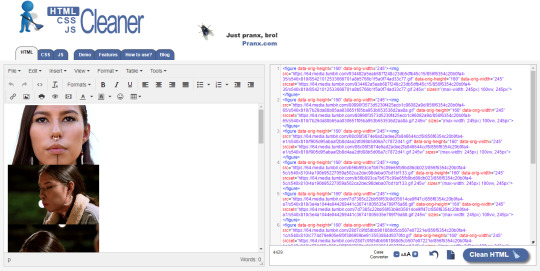
So in order to get ride of all this extra code, it's going to take a couple extra steps. First, you're going to check these boxes on the left hand side.

Now, on the right hand side, you're going to enter these under Find and Replace (copy/paste section below!!). I know you're like, uh what? Where the hell did you get those numbers? Well, I got them from our gif post code!




For easy copy pasting:
Find: <figure>
Replace: (leave blank)
Find: </figure>
Replace: (leave blank)
So after you add the specific widths for your gifs, you're also going to want to add the following:
Find: .gifv
Replace: .gif
Find: alt=""
Replace: (leave blank)
Find: /> <
Replace: /><
NOTE: If your gifs are usually the same size, I would recommend saving these snippits above on your computer's sticky notes or a draft to copy/paste for future uploads! While I do appreciate the viewer traffic, I'm sure coming to this tutorial every time is gonna get old real fast.
After all that, click Clean HTML

And now, your code should look like this! If there's still a space between your image links, just click Clean HTML again and it should get rid of it!

Now your code is nice and clean to put into your gif pages! Not quite sure how to do that? Read the Setting Up Your Sidepage section in this older tutorial!!
Resources
HTML Cleaner
My Gif Pack Page Codes
Recommended Gif Pack Page Codes (tag)
Previous Tutorial (How to upload to a Standard Sidepage)
Barebones Code (for previous tutorial)
#rpc#rph#gif pack tutorial#uploading gifs on beta#rp tutorial#beta editor tutorial#mytutorial#rp guide#me: i'm tired of this (remaking this tutorial every other year) grandpa#tumblr changing posts every five minutes: that's too damn bad!
167 notes
·
View notes
Text
🐝 * ― 𝗖𝗔𝗥𝗥𝗗 𝗧𝗨𝗧𝗢𝗥𝗜𝗔𝗟: 𝗠𝗨𝗦𝗜𝗖 𝗣𝗟𝗔𝗬𝗘𝗥𝗦
important note: only works if you have a pro or a pro plus account, and can use the 'embed' element.
― STEP ONE: PREPARING YOUR MUSIC
if you want to have music play on your carrd, the most important thing is, of course, the music. just make sure you have whatever song you want to have played in your files, and if you don't already have it, make sure to download it. now, the next step is to share your file so you'll get a direct file link you can later use in your music player code. personally i'm gonna be using and explaining the dropbox method for this, but there are other ways to do it as well. upload the music file to your dropbox ( either directly or to a special folder, whatever you prefer ) and then click the share button. then create link and copy link and you'll end up with a link that should look something like this: https://www.dropbox.com/scl/fi/j904wa1i2e229tdfa4rkb/ok-3.gif?rlkey=jy7822s2rrgaszj3jduggxn9k&dl=0 to create a direct download link out of this one, take out the 'www' and instead replace it with 'dl' so you'll have something like this: https://dl.dropbox.com/scl/fi/j904wa1i2e229tdfa4rkb/ok-3.gif?rlkey=jy7822s2rrgaszj3jduggxn9k&dl=0 save this link somewhere or keep it handy because we're gonna need it again a little later once we actually start working on the carrd.
― STEP TWO: GET THE MUSIC PLAYER ON YOUR CARRD
for the next step, we're gonna be looking at different music player codes. there are a wide variety of ready-to-use ones already available ( for example here ) or if you are good at coding, you can always create your own as well. whatever you prefer and feel more comfortable with. once you've found something you like, copy the code because it's finally time to actually put it all on your carrd. if you have multiple sections and want your music to be played in all of them, either use a header or a footer and if you only want it in one, put it in the one you want to use for this. click on the little '+' to add an embed element to your carrd ( it's the one with this symbol: '</>' ). scroll down to the 'code' section and paste the code of the music player you've previously copied there. next thing you need to do to make sure it plays the song you want is to locate the '<audio id="audio" src="link here"audio"></audio>' and replace the link with the direct file link of your music. to see if you've been successful, you either need to publish your site or save it as a template ( in case you aren't ready to publish it yet but still wanna check if everything worked as planned ) and it should display the music player and play your music once clicked.
― STEP THREE: CUSTOMIZE IT ( optional )
the last, and optional, thing you can do is customize it to your preferences. this is best done if you have a little knowledge and understanding of html coding, but minor things like changing colors can totally be done without it. for example, if you want to change colors just locate those within the code ( titled 'color' or 'background-color' and they should have a hexcode number right beside it ) and change the hexcode to whatever you want to use. or if it includes text, you can change the font size ( aptly titled 'font-size' ). you can just play around with different settings to see if you'll get something you like ― most of it within the '<style></style>' section of the code is pretty self-explanatory.
#guide.#carrd help#carrd tutorial#tutorial#carrd#rp help#rph#type: guide#( just did this for one of my own carrds so i thought why not make a tutorial if anyone else is interested in this )
185 notes
·
View notes
Text

COMO SE ORGANIZAR PARA RESPONDER UM TURNO!
Sinto que esse título pode ser meio estranho, porque todos sabem como responder um turno, ao menos, é o que estou garantindo aqui. Mas vou dar uma situação: você recebeu a resposta do turno, mas não sabe como começar a responder, de fato, abre o post e fica lendo e lendo, a criatividade não parece estar muito em alta… O que fazer?
A ideia veio em uma conversa com um amigo, onde citamos a dificuldade em escrever as respostas das threads de forma “rápida”, que, às vezes, é possível demorar alguns dias para sair algo que nos agrade realmente, ou temos a vontade de responder, mas existe a falta de criatividade para tal. E não é um caso isolado, porque já escutei reclamações semelhantes e é por isso que estamos aqui, espero conseguir ajudar. Avisando que esse guia está cheio de cores, se te incomodar durante a leitura, me avise.
Os turnos aqui são curtos, bem bobos e não condizem com qualquer personagem que tenho por aí, ou seja, não passam de exemplos.
PASSO UM: LENDO A THREAD QUE RECEBEMOS.
Jasper tinha os fios curtos e colados em seu rosto, tudo por conta do suor que escorria devido ao sol forte contra sua cabeça, mesmo que coberta pelo chapéu, aquele calor infernal não estava contribuindo para sua vida naquele momento. Segurava o timão com força, tentando manter o barco firme no mar, seu pai contava consigo para levar a tripulação para o píer e todos seguirem juntos. “Almirante Adonias, nós precisamos de provisões para os próximos dias. A tripulação que está com meu pai é complicada.” Referiu-se aos homens mais velhos, aqueles que queriam comer ou beber até o mundo acabar. Os olhos miraram o garoto loiro ao fundo do convés, o reflexo dos óculos alheios quase atrapalhando sua visão. “Você consegue cuidar disso, por favor! Chame Niming se precisar de ajuda.”
PASSO DOIS: JUNTANDO OS PONTOS CHAVES.
Agora que o turno foi lido (independente de quantas vezes o fez), vamos pegar os pontos chaves que podem ajudar na resposta. “Como assim pontos chaves, Rinn?” Simples, se você não sabe como responder o que tem, junte detalhes que chamem sua atenção antes de sair escrevendo.
Qual a situação? Em qual situação estamos inseridos, onde o turno está se passando e tudo que acontece.
No exemplo: estamos em um barco, no mar e prestes a chegar em um píer. Não sabemos quanto tempo vai demorar ou a distância em si, mas sabemos onde estamos e podemos usar desses artifícios para criar o cenários.
Quem tá sendo citado? Para quem é a resposta e quais são as outras citações?
No exemplo: a resposta vai para Jasper (a capitã? a filha do capitão? o que ela é?), quais outras pessoas são citadas? O pai da mesma, o possível capitão. A tripulação. E temos uma nova citação “Niming”, quem é Niming? Você tem liberdade de dar uma função, um traço e até criar esse NPC, visto que a outra pessoa não lhe deu mais informações.
Qual a posição do seu personagem no contexto da thread? Qual a relação entre eles? O que seu char é ali, qual sua relação com o outro personagem e por aí vai. Seja no 1x1 ou em uma comunidade, qual a relação entre os personagens?
No exemplo: Jasper e Adonias podem ser amigos, parentes ou apenas capitã e marujo. Você determina isso antes, na conexão/plot que fechou com o partner! Dependendo da relação, você pode escrever como o char se sente em relação a pessoa, veja abaixo.
O esfregão passava contra a madeira com afinco, querendo tirar uma mancha de óleo que constava ali. Era o tipo de coisa que muitos não gostavam de fazer, mas o loiro até que gostava, preferia manter tudo limpo ao seu redor. Conhecia Jasper desde os cinco anos, seus pais serviram juntos no exército e até fizeram parte da mesma tripulação, logo os filhos iam ser amigos de longa data e Adonias era muito agradecido por ser parte da tripulação da moça, ela sempre a salvou em todas as situações imagináveis, era sua melhor amiga, quase sua irmã de outra mãe.
Vejam bem, foi relatado que Adonias e Jasper se conhecem desde pequenos, por isso, ele consegue falar com tanto carinho sobre a moça. Colocar coisas pessoais, sentimentos do char pelo outro e lembranças é uma boa forma de “encher linguiça” para que a thread não fique pequena ou coisa assim.
O que vamos responder? Como fazer os diálogos? O que vai ser respondido de um char para outro?
Creio que as respostas sejam óbvias quando chegamos na questão do diálogo, basicamente só ler e colocar uma frase “aleatória” ali, mas que condiz com o que está sendo dito. Mas acho importante trabalharmos esse tópico também, principalmente para continuar o dinamismo do turno e não fazer o negócio morrer na praia, porque é complicado quando a gente manda recebe um turno e não temos uma continuação, uma outra fala para criar um novo diálogo. Meu intuito aqui é dar aberturas para que quando a Jasper responder, ela não se prender apenas no que começou. Vejamos o que foi dito no exemplo:
“Almirante Adonias, nós precisamos de provisões para os próximos dias. A tripulação que está com meu pai é complicada.”
“Você consegue cuidar disso, por favor! Chame Niming se precisar de ajuda.”
Temos dois diálogos abertos, um sobre buscar provisões e outro que envolve um NPC, o que podemos responder? Existe algo que vai gerar mais diálogos? Podemos escrever mais? Todas as respostas dependem da nossa vontade na hora, vou dar duas opções de respostas, uma só respondendo o necessário e mantendo a conversa apenas nessa roda e a outra vai envolver o que já temos disponível + uma nova linha de conversa.
PRIMEIRA OPÇÃO:
“Claro, capitã Jasper! Vou providenciar tudo que for necessário”.
“Vou chamar sim, porque toda ajuda é precisa para alimentar toda a tripulação… A nossa come bem, a dos nossos pais é ainda pior.”
Simples e usando apenas o que temos no primeiro turno, ou seja, o primeiro e o segundo diálogo. Quando a pessoa for responder, tem como continuar a conversa e aumentar, caso o partner deseje (acho importante, porque esse diálogo é muito simples e pode acabar com mais duas linhas, terminando a thread por aí mesmo, se não tiver mais movimento), é bom para todo mundo! Com “bom”, estou querendo dizer porque a) você respondeu b) tem espaço para seu partner continuar.
SEGUNDA OPÇÃO:
“Claro, capitã Jasper! Vou providenciar tudo que for necessário”.
“Vou chamar sim, porque toda ajuda é precisa para alimentar toda a tripulação… A nossa come bem, a dos nossos pais é ainda pior.”
“Inclusive, vamos usar outro barco? Acho que nossa doce Brisa Tropicana não vai aguentar um monte de gente”.
“Verdade. Estava esquecendo, parece que o Ycaro vai ficar no píer dessa vez, problemas familiares ou coisa assim. Ele já falou contigo?”
Temos as respostas da primeira opção e duas novas, que podem ajudar a sustentar a thread por mais tempo. Usei as mesmas cores, laranja e vermelho, para mostrar que correspondem aos dois diálogos que temos em aberto no jogo. Invés de esperar abrir um espaço para fazer tais comentários, optei por colocar de uma vez para que o diálogo entre Adonias e Jasper não morra na praia. Pensando no partner que pode ficar sem criatividade para continuar a “única conversa” presente no texto, por que não colocar mais falas? Por que não deixar seu personagem falar tudo que quiser, mas que, claro, se mantenha dentro do contexto que estão inseridos?
Penso que ao adicionarmos mais diálogos em uma cena temos um leque de oportunidades, dentre elas, quero destacar: ideias para threads futuras, usando nosso exemplo inicial, a relação dos dois x os pais; a chance da thread durar muito mais e desenvolver ambos os chars, porque se não evoluirmos a cena, infelizmente, a thread vai ficar cansativa e monótona até que um dos lados queira encerrar e abrir uma nova, criando uma pequena bola de neve que pode incomodar, em determinado momento; e o mais importante disso tudo, você acaba desenvolvendo mais seu personagem, fazendo ele falar de vários “assuntos” e mantendo uma dinâmica confortável. Creio que ajude também na otimização de tempo, por que esperar sua vez de responder, de novo, para adicionar outro diálogo, quando se pode fazer enquanto for sua vez. Isso pode ajudar até seu partner a ter mais musing para responder em seguida!
Nada mais justo que mostrar o turno final para vocês, visto que o comecei e fiquei empolgada em escrever. Estarei usando a segunda opção de diálogos, pois gosto de fazer muitas conversas em uma única resposta.
O esfregão passava contra a madeira com afinco, querendo tirar uma mancha de óleo que constava ali. Era o tipo de coisa que muitos não gostavam de fazer, mas o loiro até que gostava, preferia manter tudo limpo ao seu redor. Conhecia Jasper desde os cinco anos, seus pais serviram juntos no exército e até fizeram parte da mesma tripulação, logo os filhos iam ser amigos de longa data e Adonias era muito agradecido por ser parte da tripulação da moça, ela sempre a salvou em todas as situações imagináveis, era sua melhor amiga, quase sua irmã de outra mãe. “Claro, capitã Jasper! Vou providenciar tudo que for necessário”. Garantiu sorridente, apoiando o queixo contra a base do esfregão, a citação da tripulação mais velha o fez suspirar, teriam trabalho mesmo até chegarem ao destino final. “Vou chamar sim, porque toda ajuda é precisa para alimentar toda a tripulação… A nossa come bem, a dos nossos pais é ainda pior.” Brincou rindo, quase gargalhando antes de voltar o que fazia, esfregando o restante do espaço ou quase isso, porque voltou a olhar a amiga, muitas ideias e dúvidas. “Inclusive, vamos usar outro barco? Acho que nossa doce Brisa Tropicana não vai aguentar um monte de gente”. Bateu a destra, delicadamente, sobre a borda de madeira, amava aquele barco com sua vida já que foi o primeiro que a jovem tripulação conquistou e que o rapaz cuidava com tanto amor. “Verdade. Estava esquecendo, parece que o Ycaro vai ficar no píer dessa vez, problemas familiares ou coisa assim. Ele já falou contigo?”
PASSO TRÊS: CONSIDERAÇÕES FINAIS E MUITO BLAH BLAH.
Antes de continuar, quero reforçar que não estou impondo regras para como você deve responder seu turno, mas creio que ter uma base/ajuda para traçar o pensamento da resposta pode ajudar; pessoalmente, ia adorar ter algo assim quando comecei na tag e tinha problemas em responder os jogos.
Esse é um método simples para te ajudar a pensar e elaborar uma resposta que te agrade, se for mais ou menos é seu critério; não se force a responder quando não tem pique para tal, porque é muito comum fazermos respostas no automático e depois de arrepender, claro que podemos alterar após o envio, mas se não der tempo, vai se lamentar, um pouco, sobre não ter pensado melhor ou feito de outra forma.
Agora que as dicas foram dadas, vamos recapitular os pontos importantes, como um mini roteiro para te ajudar a responder seus jogos. Do fundo do coração, espero que esse guia ajude alguém a responder uma thread! Mas vamos recapitular, recebemos o turno, mas a criatividade faltou, então vamos salvar em algum lugar ou marcar que temos um turno para responder - caso seja no discord ou dm, porque se for no tumblr, você pode colocar nos rascunhos. Leia o turno de novo, quantas vezes for necessário para que algumas ideias surjam em sua mente. Na administração, temos um termo chamado BRAINSTORMING, que é uma chuva de ideias que são lançadas em uma discussão e você pode ter isso ao ler uma thread; quando acontecer, anote o que está pensando. “Posso colocar essa frase, enaltecer esse detalhe” e por aí vai, se achou interessante, anote! Mesmo que descarte ou altere depois. Mas vamos fazer um roteiro com tudo que aprendemos.
Após ler e fazer algumas anotações, pense qual a situação que o turno está ocorrendo. Qual o local? Como ele é? Existe alguma distância de um espaço para outro? Existem outros locais, que ainda não foram explorados? Perguntas nesse estilo podem ajudar a verificar a situação que os personagens estão.
Além do seu char e do parceiro, temos outras pessoas sendo citadas? Seja em um comentário, contando algo que ficou sabendo de fulano, até uma aparição breve de ciclano no espaço. É um NPC e é muito bom utilizarmos deles para construir uma cena.
Qual a relação entre os personagens? Eles são conhecidos, amantes, amigos de longa data, desconhecidos, etc. Me diga, o que são um para o outro? Quais os sentimentos do seu char sobre aquele que está junto? (É uma boa forma de “encher linguiça” e fazer um turno maior, mas que, ainda assim, dê um desenvolvimento legal e não pareça tudo jogado ali).
Quais são os diálogos apresentados no texto base (enviado pelo partner)? Como você pode continuar a conversa? Rascunhar ideias de resposta pode ser muito útil, talvez você não use nenhuma delas por ter uma nova ideia na hora de responder, mas é bom ter opções.
Outro ponto: saber quando acabar um diálogo e começar um novo, ou até retomar algo de outras threads (se já tem mais que uma). Ter essa flexibilidade e tato sobre as conversas do seu jogo, não insistir em algo que vai ser robótico.
Sei que anotar tudo pode ser cansativo, até inútil, porque é só ir lá e responder invés de ficar pensando, mas um turno é quase como uma cena de filme/série, onde existe um roteiro. Nós podemos negar esse ponto, mas quando respondemos algo, acabamos pensando com antecedência antes de escrever… Apagamos, mudamos palavras, caçamos termos novos. Isso não é fazer um roteiro? Rascunhos existem e sei que muitos fazem, não é regra, mas isso pode ajudar muito na hora de escrever. Não só para joguinhos em um rpg, pra vida mesmo, uma redação, um artigo científico ou o que for, ter um rascunho é ótimo, porque você consegue mudar até estar satisfeito. Livros não são escritos de uma vez, os autores fazem inúmeros rascunhos, um capítulo pode demorar meses para ficar agradável e chegar na versão que é impressa, então, me digam com sinceridade, por que os turnos precisam ser diferentes? Por que precisam ser tão imediatos? Recebeu e respondeu. Não tem problema gostar disso, eu mesma já fiz inúmeras vezes, mas não sem fazer um breve rascunho, ao menos, um mini roteiro do que vou colocar ali.
Parece surreal estar falando isso, porque parece que estou falando coisas fora da caixinha ou que rolam apenas no meu pessoal… Mas quero trazer uma nova visão para quem desejar aceitar. Já tive muitos problemas com meus turnos, tinha vergonha e raramente ficava satisfeita… Tenho threads que nem gosto de ler novamente, por vergonha, por saber que podia ter escrito melhor e ter dado mais abertura para meu partner. Tudo que estou falando é para mostrar um caminho de aprimoramento, não na escrita ou na organização, isso vai de cada um e no seu tempo, o aprimoramento é mental, da minha ‘neura’ em saber que podia ter feito melhor; seguindo isso, de um jeito ou de outro, vou acabar satisfeita.
Eu bati muito na tecla sobre os diálogos e sinto que pode abrir a discussão de turnos grandes x médios x pequenos. Isso não importa muito, como o meu amigo @hwares já mostrou em seu guia, menos pode ser mais! Muitos diálogos ou ações não vão tirar seu estilo de turno, tem como fazer algo pequeno/mediano com muitos diálogos e poucas ações (um face to face/f2f, por exemplo), assim como é possível fazer as famosas bíblias com muitas ações e poucos diálogos, ou vice versa, talvez até algo balanceado entre ambos os polos. Inúmeras possibilidades, basta tentarmos, dar o primeiro passo. Existe beleza nos menores e maiores jardins!
E acabamos por aqui, espero mesmo ter sido útil e chat/inbox estão sempre abertos para vocês. Qualquer coisa que surgiu enquanto lia esse guia, por favor, me deixe saber, se concorda ou discorda do que foi dito, pode me falar. Eu curto receber feedback.
#♡ · 🔎 : guides#♡ · 💭 : help#( about : turnos )#♡ · 🎀 : rinn talks a lot#♡ · 🌸 by sakura#rp br#1x1 br#rph br#rph#exodusmusing
105 notes
·
View notes
Text
✧・゚ A short and easy workaround for Reblogs with Beta & XKit Rewritten

Disclaimer: This also seems to work with old Legacy-Threads when reblogging with the new Beta-Editor bc XKit Rewritten doesn’t work with Legacy. The whole trimming order and process of both combined can be confusing, but it’s important so the post doesn’t get fucked up. So technically, it's also helpful for Beta-Reblogging in general. (video below)
SO, IF YOU WANT TO AVOID DOUBLE-POSTING of your own reblog, do the following:
Hit reblog (make sure you’re using Beta).
Enter reply, whatever.
Safe to drafts.
Remove the first post with Trim Reblogs.
Safe.
Refresh drafts.
Remove your own reply that now shows twice with the Beta-Editor. You will only have one option to remove here, so that makes it easy.
Refresh.
Tadaaa.
In this way you can preserve your partner's reply if you want to, since the blockquote-format won't work like that anymore. So hopefully, reblogs with the Beta-Editor & XKit Rewritten should be easier now for you and your partners without having to move your whole Legacy-Thread to a new post after this measure. I am very nostalgic over my old stuff, so that's a reason why I don't want to do it. If you have additions or experience possible errors, feel free to add them.
PLEASE NOTE THAT THIS WILL ONLY WORK if your partner reblogged their response without any XKit-Extension. Just a plain reblog.
#rph#rpc#beta#editable reblogs#trim reblogs#xkit rewritten#new xkit#legacy editor#tutorial#*mine: edits#[ I just needed a short guide for my horrible brain ]#[ just short; no additional info ]#[ just wanted the essentials to get rid of the double reply issue ]#[ maybe it helps you too ]
460 notes
·
View notes
Photo
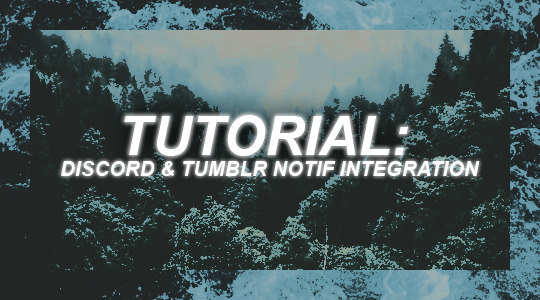
TUTORIAL: using discord webhooks to get tumblr notifications in discord
hello everyone !! i’ve been using discord webhooks to get notifications in a channel of a personal server when i receive a new reply, ask, mention, or follower on any of my rp or personal accounts. you are also able to read the received asks, replies, and mentions you get right in the discord channel.
as someone with a fair number of separate tumblr accounts, it’s been a great feature to avoid having multiple windows or tumblr sessions open at once while still being aware of new activity on all my tumblr blogs.
it’s super easy to set up and requires only very basic knowledge of tumblr and discord !! the tutorial walks you through every step and shouldn’t take longer than 5-10 minutes at most to set up ( depending on how many blogs you are linking ).
not sure if this is something you’re interested in ?? examples of this in use are at the bottom of this post !!
written 06.16.22. last edited 02.23.24.

GETTING STARTED
this integration is extremely easy and straightforward to set up, especially if you’re already familiar with discord !! you do not need discord nitro or anything special in discord for this to work.
first and foremost, you will need a “personal server” in discord so you can set the channel where you will receive your notifications. the way i have mine set up is a category dedicated to webhooks and a channel for each muse or account. if you are using this to pull in asks from an rp main or other shared account, you could also pull the notifications into your ooc server in a private admin-only channel.
create the channel you want your notifications to go to BEFORE proceeding.

ON DISCORD
in your personal server ( or the server you will be pulling the notifications into ), right click on the server name to head to server settings > integrations > webhooks.
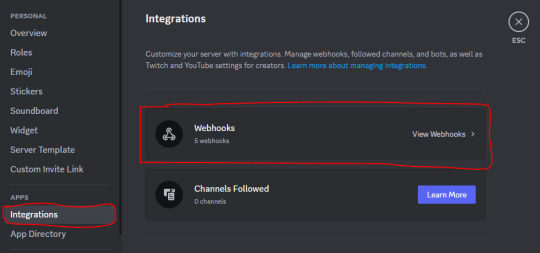
click “New Webhook” and you will see the default webhook set up. this page is also where you can return to later and adjust any of your existing webhook settings if needed (eg. post to a different channel, change a webhook icon) or delete a webhook if it is no longer needed.


you can set your webhook icon and name ( again, i usually correspond this to the particular muse the webhook will be used for ), and then select the channel you want your notifications to go to from the drop down.
you can have ONE webhook for each blog ( sideblogs can be separated out ) if you wish. at this time for a single blog you cannot have different notification types or on a post-by-post basis post to different discord channels as a blog can only use one webhook at a time (and therefore must post to the same channel).
i currently have one webhook for each rp account i have that each post to their own channel, as well as several webhooks which collect any asks i receive on my personal non-rp accounts and post to the same channel.
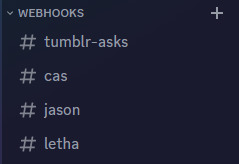
you can have multiple webhooks post to the same channel by selecting the same channel in the webhook setup or use the same webhook across multiple blogs by pasting the same webhook url into each separate blog ( but it will look the same for all of them, of course ).
once your webhook looks like you want it to, click “Copy Webhook URL”.

HEAD TO TUMBLR
this integration is part of tumblr labs so you need to make sure you have those enabled. on your account, head to settings > labs. toggle on “Enable Tumblr Labs”.
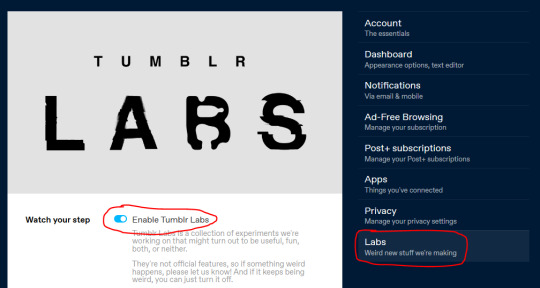
scroll to the bottom and toggle on “Tumblr to Discord Webhooks”.

head to the settings of the blog or sideblog you want to link the webhook to ( the same place where you can control your ask box, who can message you, your url, etc ). scroll to the bottom and there is new section called “Discord Notifications” !!
08/10/23 edit: some users have reported that the “Discord Notifications” section does not always show up immediately. the settings page needs to completely refresh for the section to show, so first try manually refreshing the settings page. if this does not work, toggle the tumblr to discord webhooks off and on and refresh. it has reportedly always shown up with a little time and persistence.
paste the Webhook URL you copied from discord in the text field and then toggle the items that you wish to receive notifications for in discord.
09/10/23 edit: if you receive an error saying the webhook url is not valid upon pasting it into the entry box, make sure the webhook url uses ‘discord.com’ and not ‘discordapp.com‘. the webhook should look like: https://discord.com/api/webhooks/<insert long series of numbers here>/<insert long series of upper and lowercase letters>. updating your discord app is also recommended if you have not done so recently.
in order, i am receiving notifications on : any new followers, any new asks, any new reblogs ( replies or if someone reblogs a promo or otherwise ), any new replies ( if someone comments on a post of mine ), and any new mentions (if someone @’s you in a post). in the next section, i have pasted screenshots of what each notification looks like in the discord channel.

12/29/23 edit: you still receive a notification in discord when you reply if you wrote the starter ( even though tumblr has removed activity notifications when you interact with your own posts ). i have also noticed that sometimes two simultaneous notifications will come in for your partner’s reply if you wrote the starter ( eg. your partner’s reply shows twice on discord ).
this ends the tutorial — you should be all ready to go !! feel free to send yourself an ask or follow one of your own blogs to test it out.

WHAT IT LOOKS LIKE IN USE...
in general you are told who the notification is from, and if there is something new to read, it is displayed !! where applicable, the top text in blue is a hyperlink directly to the post it is notifying you of !!
NEW FOLLOWER NOTIF:

RECEIVED ASK:

NEW REBLOG ( non-reply / no added caption ):

NEW REBLOG ( a reply ): if using the Legacy editor with editable reblogs, your reply will show first (shown in yellow bracket), followed by your partner’s reply (shown here in red bracket). unfortunately, formatting & blockquotes don’t come through, but it works in a pinch if you don’t want to log in to read the reply !!

with the beta editor + trim reblogs, you will just see your partner’s new reply ( not your own ). formatting still doesn’t come through, but everything is readable!

A MENTION: you are told who mentioned you in the post or comment as well as the comment or post itself. you can click the blue link text at the top to be brought right to the relevant post! (as of 02.23.24. it seems notifications for mentions in posts are broken though they still work when you are mentioned in a comment. i have sent a ticket to staff notifying them of this ).


CONCLUDING NOTES
i hope you found this helpful !! and if you did, please consider giving this a like or reblog.
if you come across any bugs while setting this up, please consider dropping something in my ask so that i can include it in the tutorial. thanks so much <3
1K notes
·
View notes
Text
a quick guide on how to plot in a rp group
Hello friends. As I journeyed through different groups I noticed a trend in interactions with writers and trying to plot with them for their characters. It seemed like there was a disconnect on what plotting means and that was making answering plot calls really difficult and frustrating. I wanted to whip together a quick guide with actionable items to help with plotting! However, I think it's important to also note that plotting doesn't have to be deep — they can something simple that leaves a lot up to chemistry. Even "random" interactions can be used for plotting purposes for people that really work well off of chem. Everyone is different, and both plots and chem are great ways to write together!
plots vs connections
One of the biggest mistakes that I've seen with plotting is that people mistake plots for connections and vice versa. A Plot is an actionable item that you can use to write the characters doing something. It can be a broad character arc, or several points of conflict or interaction that generates threads. True plots make it easy to generate a thread from some context to what we think will start the interaction between the two characters.
examples: one character took another character's coffee order. one character caught another character from falling. one character likes art and the other doesn't and they went to a museum.
A Connection is how the characters know each other. This can be familial relationships, platonic relationships, romantic relationships, and so on.
examples: they met at a coffee shop. they went to the same festival. they are exes. they're cousins.
Often, connections are a great place to start, as the plot can be built off from the connection. However, if it's left at just the connection (such as, they're cousins!) it can be hard to create a thread or interaction from the connection. If the characters are cousins, or they did meet at a coffee shop, what's their relationship like? How did that first coffee interaction go? Or do you want to write that coffee interaction based off chemistry? Either way, those questions help you plot!
tips on ways to maximize plotting
Read the other character's bio or about. If you don't have one for your character, make one so that people can use these content pieces as a way to start to think about their character in context to yours. Most people are pretty good at figuring out a connection, but have an issue taking it to the actionable idea. Think about general interactions you have had with people in your life, or something you've witnessed, one of those could be starting point for a thread!
Create a wanted plots page that has some simple interactions you'd like to explore. People might not read it, but then you've at least got ideas for people who might be struggling as well to think of how to plot with your character.
Check out the wanted plots tags, there's tons of great ideas for unique plots that you could use and adapt for other plots.
Think about what parts of your character that excites you. What quirks or strengths do they have that make for interesting interactions with people? I find that starting here often helps to build threads I am excited for — chemistry based ones!
Use the yes, and or the no, but methods to build in conversations with other writers. Meaning that if someone comes up with something you think could work, agree with it and then build off of it. If the idea doesn't work, however, come up with something else that is more in character that could work.
Don't be afraid to send something off the wall, and don't be afraid to turn something down that doesn't work, just be willing to build off those ideas!
If you're into chemistry over plotting, think of places a starter or thread could be at and what the two characters could be doing. This could be in addition to a connection you've selected.
I hope these tips have helped, and I wish you the very best on your rp plotting adventures!
28 notes
·
View notes
Text
voodoo , witchcraft and the rpc
or why you should think before including voodoo in your roleplay . ( this will contain discussions of slavery and racism , for my own comfort i will not be going into true detail of these and the other dark topics surrounded with the stereotypes )

now , i would like to preface this by saying i am not a practitioner or follower of the voodoo ( vodou but for the sake of this post we'll use voodoo ) religion , however i am black ( caribbean specifically ) and after seeing an uptick of voodoo in the rpc lately , it's occurred to me that this puts me in the position to say something . so lets get into it .
witches and magic have been a staple of both the horror and supernatural genres for years and voodoo has worked its way into the entertainment industry alongside this but lets get into what vodoo actually is : a religion with its own spiritual hierarchies , ritual ceremonies, customs and practises .
a closed religion at that .
unless you are invited into it , you can not and should not practise it . it was developed by african slaves - it's entire foundation incorporates blended religions , cultures and sufferings of african slaves . it's commonly known that enslaved people were separated from their religious and spiritual identities , the only way that this knowledge and religion still exists is from being passed down from generation to generation .
'what if my muse was invited into it?' in my opinion , you as a mun who has not been invited into this religion who does not practise it , can not fully understand the weight , traditions and complexities of it . even with research , you will be missing pieces of the information .
closed religion aside , lets now talk about the stereotypes surrounding voodoo and magic .
the term black magic was often used in regards to african spirituality and in media it's not uncommon to see voodoo be used and misrepresented as something backwards , perverse and downright evil . where does this come from ? well as simple as i can make it , it's racism . voodoo and hoodoo were used to further demonise black people , it gave us the reputation that we could enslave you , that we would take away your will and autonomy and force good innocent white people into doing things they didn't want to do ( ironic isn't it ) think of media such as ahs or even princess and the frog for modern examples of how this stereotype continues .
when portraying black witches who dabble in the stereotyped portrayal of 'voodoo' , or white characters with 'voodoo' superpowers it's important to be aware of the history and of the image you will be projecting with your character .
this is not to say you can't play black characters as witches or other magical species , but you can do so in a way that doesn't enforce damaging stereotypes and tropes . ( bonnie bennet from tvd is a witch the same as her many white counterparts , the most recent reboot of charmed features black female leads as powerful witches - although both of these are not perfect depictions )
tldr : this is no where as detailed as i wanted it to be as im saving my energy and i can't tell you what to do but voodoo is a closed religion that should not be used in roleplays as a source of magic or witchcraft . please respect it and it's roots . if you want to play a black character with magic , do so the same way you would their white counterparts but be aware of stereotypes ( particularly the magical n*gro stereotype )
as always im open to questions and comments on this . my knowledge is not absolute so i'm happy to amend things in this post . keep discussions civil and polite pretty please and remember that people of colour do not owe you education , especially at their own expense so be patient and listen .
#rp psa#writing guide#black character resources#voodoo#*made by m#this was nervewracking to write but i feel its important to know#black stereotypes#rpc#rph
124 notes
·
View notes
Text
counseling 101: the background.
hi everybody! my name is riley, and i'm a substance use counselor. i've worked in both inpatient and outpatient, i've been in this field since i was 19 and have been professionally working for 2 years. i'm currently in grad school for clinical social work, pursuing my lsw and my clinical licensure (lcsw). i wanted to write a guide on what it "means" to be a counselor! i will be discussing the specifics of a substance use counselor in another post. (it will be linked below.)
disclaimer:
do not take this as professional advice for all counselors, therapists, psychologists, or social workers. this is my background, my information, my experiences, and my specific expertise. this will include the basics of schooling, training, certifications, frequently asked questions, and things you might not realize, as it all pertains to me! what works for my patients and i may not work for you, so be mindful this is not a "my way is correct and your therapist is wrong," as i believe in the pct model of meeting everybody where they're at.
even counselors at my exact experience level and education level may do things differently than me, and that's perfectly fine! i just wanted to write this to give some insight if you're interested in writing a character who is a therapist, or who goes to therapy. or if you're just interested in general! i could give reminders upon reminders but i just need to say that this is all my thoughts and path in life! this is not the end all, be all. and with that, let's get started. (if you have further questions or need something clarified, please feel free to reach out but just for clarification: i'm not your therapist, i'm not being paid for this, please don't trauma dump, and always remember i'm a human just like you!)
education:
your education is based a lot on your "experience" (which i'll talk about next) and i know that doesn't make sense but just stick with me! the very basics of what you need is a bachelor's in a "social work" setting. which includes, but is not limited to (because i forget): psychology, social work, sociology, criminology. these are the foundations for your specific field of work! i'll just be talking about counseling in general, or about substance use, as i am unaware of the other jobs / fields you can get with different degrees.
if you're trying to get a "good" job (livable wage) i would suggest getting a master's degree in your field of work. though, i will say, you can get lucky and survive off of your bachelor's (like i currently am!) but i would strongly, strongly encourage further education which will lead into certifications and licensure, and that will cement your place in the field and open up the job field entirely. with a bachelor's, they often want anywhere from 1-5 years of experience. with a master's, many places will take you with 0 years of experience, up to 5 years, depending on your field and what the company wants.
i currently have my bachelor's in psychology. psychology is such a broad degree that unless you're specifically going to be a clinical psychologist or gain your doctorate, i would choose another field. i didn't know i wanted substance use specifically until i was 19, which i'll speak about in experience, but if i did not choose the substance use field, i would most definitely would have had to immediately get a master's and be licensed in order to receive well paying jobs with just a psychology degree.
experience:
you don't need a master's to get a job in this field, but you do need experience (there will be places that take bachelor's with little to no experience, but will pay you next to nothing). the best thing to do is find an internship! i think the easiest way will be through your school, and when you're picking one of the aforementioned degrees, it should be an option when picking out classes - many times, universities have people that specifically work with internships.
when i was getting my bachelor's degree, it was my first semester and i was 19 when i was offered to interview for an internship through my school. i got accepted on the spot and was apart of it even after i got my "credit" for the semester and continued for two years! i worked in houseless shelters in my county and was running daily men and women's groups, 2:1 sessions (2 counselors to 1 resident), debrief sessions with the other interns, and supplying a resource booth for the residents.
without this internship, i truly and wholeheartedly believe i would not have gotten any job in this field. it's a dog-eat-dog out there in the realm of psychology (which includes all those fields above) and i truly got lucky to get my start this way. if you don't have the time, motivation, or money to gain a master's, i would highly suggest getting involved in internships as soon as possible in order to get those years of experience!
certifications:
this has a wide range of things! i can only speak to what i've received, and what i know about. this also includes specific training to the sud field, but i won't go in depth about it until the next post i do! the certification i will always need is my cpr. i know that sounds silly, but working with people, in general, i feel like everybody that is able to should receive their cpr certificate!
now, with a bachelor's, they're not really expecting you to have anything else. but! you can. i currently have my milieu certification. which sounds fancy but it just means i'm certified in "psychotherapy in which the patient's social environment is controlled or manipulated with a view to preventing self-destructive behavior." i could've explained it myself, but google does wonders and makes me sound smart! i got this through my internship. it was required and within the first two weeks, i went through trainings and seminars to receive the certificate.
another thing i can receive with only a bachelor's (that's specific to sud) is my cadc certification. it stands for certified alcohol drug counselor. in order to do this, you'll need supervision hours from a clinical / licensed or otherwise appropriate supervisor or director. once i receive upwards of 300 hours of documented supervision, i can take my cadc exam and become certified. this can also enhance what jobs are available to me because many jobs ask for this certification in place of a clinical license (some don't, but you know... some do!)
currently, i'm working on my master's and may potentially work towards my cadc along the way, but once i receive my master's i can get my caadc, which is certified advanced alcohol drug counselor. it's just more hours and an exam! not sure which path i'll take yet because grad school is killing me, but those are what's offered in my field and what i'm interested in! of course there's other certifications involved, but that's for you to decide.
licenses:
now comes the fun part. again, what license you want or go for is specific to your field. there's a ton of counseling licenses, but the main ones that are down my path are lpc (licensed professional counselor), lsw (licensed social worker), and lcsw (licensed clinical social worker). so let me explain a little bit about each of them, and what i'm personally doing!
lpc: licensed professional counselors "are trained to offer assessment, therapeutic interventions, consultation, program evaluation and follow-up services in a variety of settings including schools, hospitals, community agencies, private practices, religious centers, group homes and more. lpc's can also independently practice counseling, meaning they can establish or join a private practice and directly bill insurance companies or receive cash for counseling services." can: work independently, diagnose mental health conditions, and supervise for clinical hours. this license is primarily for direct mental health care.
lsw: licensed social workers can "render services that rely on a special knowledge of therapeutic techniques, human personalities, and social resources. this includes: helping people become socially adjusted as individuals and members of a family or community, you cannot work independently; you must work in the affiliation of an agency or social work service provider." cannot: work independently or diagnose mental health conditions.
lcsw: licensed clinical social workers "support people through various challenges by providing general counseling services, crisis intervention, mental health therapies, substance use support, and other key services. lcsw's may also supervise the work of lsw's. they may work in schools, hospitals, elderly care facilities, private practices, and even the courtroom—social workers are often called upon as witnesses in court cases. the main thing to remember is that this license gives them freedom and responsibility to make independent decisions about diagnosis and treatment plans." can: work independently, diagnose mental health conditions and supervise for clinical hours.
difference between lpc and lcsw: though both are similar in their ability to work independently, diagnose mental health conditions, and supervise for clinical hours, there is one main distinction between the two. lpc's are more patient focused and lcsw's utilize a patient's entire life. to put it, well... better, i've turned to google! lpc's "focus on helping clients with specific issues, such as mental health diagnoses, substance use, or behavioral issues. they also can specialize in different types of counseling, including substance use or marriage and family counseling." whereas lcsw's "assist their clients with finding and accessing resources that promote a client’s quality of life and may be involved in the legislative process dictating these services. social worker training usually includes counseling techniques and training, best practices, and finding resources for clients."
general overview:
so, with a bachelor's and no cadc or license, what can i do? well! i counsel<3 i speak to my patients about their substance use, i speak to them about their family, i conduct family sessions, i delve into their trauma, i utilize cbt, pct, mi, and grounding techniques. i run daily groups with my caseload, i run bi weekly groups for the entire community, and i initially assess them for proper level of care. i submit asam's, prepare treatment plans and update them weekly, and work with them on their goals while in and outside of treatment. all of this will be spoken about further in my sud counseling guide.
a day-in-the-life timeline looks like: clock in, check any updates / notes on my patients, go to treatment team with the clinical staff / case management / nursing and doctors (which pertains to the level of care my rehab is - you will not always have this, dependent on inpatient or outpatient and other factors), i run my daily group for an hour with my patients, i do group notes for them, i have my lunch, if i have that afternoon group for the whole community i run it, then i fit in any individual sessions or initial assessments that i need, i complete all progress notes for the day, and i clock out. in between, i handle patient crisis', ama's, behavioral issues, and general questions.
modalities:
what are modalities? "modalities are approaches or methods that a therapist will use to help you reach your goals. modalities fall into broad categories, such as cognitive and behavioral, somatic (body awareness), experiential (play or art therapy), and more." these vary by counselor-to-counselor. this is what works for the counselor and the patient and instead of including the quadrillions of therapy modalities, i'll just talk about the ones i use the most! (also side note that i believe most therapists, within reason, should be utilizing pct and mi but... that's a soapbox for another day). i'll be talking more about why i use - these in relation to sud - in my other post.
cognitive behavioral therapy (cbt):
i want to start this off by saying that cbt is very useful in the beginning stages of therapy! oftentimes, people utilize dbt or somatic therapy after they've "accomplished" cbt. i employ cbt due to, more often than not, patients not having a solid foundation for recovery or changing their ways. so what is cbt?
"cbt is a psycho-social intervention that aims to reduce symptoms of various mental health conditions, primarily depression and anxiety disorders. cognitive behavioral therapy is one of the most effective means of treatment for substance abuse and co-occurring mental health disorders." in a shorter sense: i use cbt in order to "change" the way somebody thinks.
things that are apart of cbt therapy (and can be incorporated in other forms of therapy) include cognitive distortions, grounding techniques, actively engaging in combatting their automatic negative thoughts (ant's), and encompassing pct and mi in order for the patient to understand why they need to change their thoughts / actions, how they can change them, and the results of changing them. this will go more in depth in my sud post!
patient centered therapy (pct):
pct isn't necessarily for everybody, as many patients may have difficulty even coming up with what their issues are or potential solutions. but by utilizing pct, counselors may be able to support a patient to an "answer" or realization without giving them the answer - i find it beneficial to voice my issues and concerns so i'm able to form my own solution even without my friends saying anything! it's very limited involvement from the counselor as far as "telling them" what's wrong and giving them "choices" to fix it.
"during person-centered therapy, a therapist acts as a compassionate facilitator, listening without judgment and acknowledging the client’s experience without shifting the conversation in another direction. the therapist is there to encourage and support the client without interrupting or interfering with their process of self-discovery, as they uncover what hurts and what is needed to repair it."
pct is really important, in my opinion, because it allows patient the autonomy to make decisions for themselves, while also giving them support. a counselor is supposed to help, not be a brick wall, so as much as the patient is allowed to freely roam through their thoughts and feelings, i've found a nice balance between pct and cbt when the patient may not have a specific answer or understanding for themselves.
motivational interviewing (mi):
"mi is a guiding style of communication, that sits between following (good listening) and directing (giving information and advice). it's designed to empower people to change by drawing out their own meaning, importance and capacity for change. mi is based on a respectful and curious way of being with people that facilitates the natural process of change and honors client autonomy."
when i speak about "guiding" a patient to a different way of thought, or to a "solution", mi is what i'm talking about. my entire approach to counseling is not to give them the answer, because many times they may know the "right" thing to do (stay away from drugs - duh, not explode in anger, not cut people off, etc.) but allowing them this space to speak freely so i can ask them questions for clarification, let them know somebody is listening to them, and building up that therapeutic relationship is the entire point for me.
mi is where the trifecta of these modalities lays. i can utilize cbt in an effort to change their mindset or offer new ideas or "reasons" why they may think / act like that, as well as incorporating pct so that they can come to the realization themselves! it's all about balance and which modality is right for that exact moment, for that patient. it also allows me to be entirely present in the conversation. i often find myself dissociating in my day-to-day life, as many people do, but by using mi, i have to listen in order to ask questions or repeat what they said back to them. it's beneficial to all!
the end:
thank you so much for reading this! i know this was just the basics, but if you want to write a character who's a therapist or who's going to one, i hope this helps beef up that background for you! again, this is specific to me and my sud field, and there's a million other certifications and licenses for general counselors.
substance use disorder counseling post. (will update when post is done).
#rpt#rpc#rph#idk what else to tag<3 KSJAHS#rp guide#character guide#career guide#*#*guide.#counseling 101.
39 notes
·
View notes
Text
general question for the rp community/rph+ tags. something i've noticed in the rpc a lot lately is a resurgence in writing characters who are s*x/seggs workers to some degree. what i would like to do is to provide a resource for writers that allows space for a richer and more complex understanding of the industry and how it functions so that writers can create more nuanced and multi-faceted characters who participate in s*x work ( whether that be camming / 0nly f@ ns / esc0rting ect ). please note: this guide would be written through the lens of both academia AND as someone who participates in s*x work. i'm very exhausted coming across sw narratives in the rpc that depict the industry as either very one note, conflating it with s*x trafficking or for s*x work to be some sob story / trauma porn narrative for mary sue characters who need a little bit of spice.
obviously i'm not trying to shame anyone who does write a sw character. we all (most of us) strive to do our best when it comes to creating well rounded representations of characters who are minorities or exist outside the social norm to some degree. however, i feel there is still much to be done in the way of opening up discussions about how to better represent s*x workers and unpacking a lot of the internalised wh0rephobia that (civilian) writers often have which ultimately impacts their writing and the way they may depict their characters who happen to be s*x workers.
but of course i'm also not interested in putting in all that time / effort in an attempt to offer an educational resource for people who are going to disregard it naturally because of the subject matter hence this interest check of sorts.
so, with that being said who would be interested in a guide / safe space to discuss s*x work as a plot device and how to create better s*x worker characters?
37 notes
·
View notes
Text
GUIA PARA CRIAÇÃO DE PERSONAGENS AUTISTAS (parte 1).
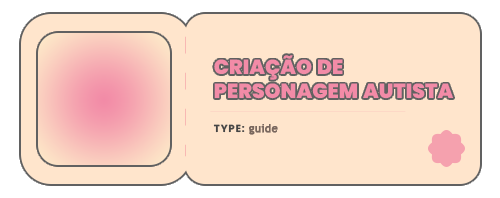

depois de tantos imprevistos, enfim trago a primeira parte do guia sobre personagens autistas. venho salientar que sou uma pessoa autista, mais especificamente encaixando atualmente no nível 1 do espectro e diagnosticado tardiamente na vida adulta. mesmo vivendo com o transtorno durante minha vida inteira, não sou uma biblioteca de autismo ambulante, então tudo escrito aqui é com base nas minhas vivências, estudos sobre o assunto, explicações e orientações psiquiátricas / neuropsicológicas que recebi e sites dedicados a saúde. erros podem ocorrer e estou mais que aberto a correções vindo de pessoas da área da saúde e depoimentos de outros autistas. com isso em mente, vamos ao guia.
se for útil para você, peço que deixe um coração ou um reblog (🧡).

O QUE É O TEA?
Primeiro, precisamos entender do que se trata o transtorno conhecido popularmente como autismo.
"O transtorno do espectro autista (TEA) é um distúrbio do neurodesenvolvimento caracterizado por desenvolvimento atípico, manifestações comportamentais, déficits na comunicação e na interação social, padrões de comportamentos repetitivos e estereotipados, podendo apresentar um repertório restrito de interesses e atividades." (fonte: ministério da saúde)
Apesar da definição estar muito resumida, em palavras mais simples é um transtorno que mexe com o desenvolvimento neurológico (área do sistema nervoso, casa dos famosos neurônios) do indivíduo, afetando suas habilidades:
psicomotoras: capacidade de sincronizar os movimentos usando cérebro, músculos e articulações.
cognitivas: processo de construção de conhecimento, sendo necessárias capacidades mentais como memória, atenção, linguagem, criatividade e planejamento.
psicossociais: socialização, cultivar relações e o convívio com a sociedade.
Com todos esses fatores, alguns podem achar erroneamente que o autismo é uma doença, no entanto, não é o caso. O autismo é um transtorno e não tem cura. Doenças e transtornos apesar de estarem ligadas a saúde não tem o mesmo significado.
doenças são caracterizadas pela falta de saúde e adoecimento do corpo, geralmente é um problema de saúde catalogado, com sintomas claros e origens conhecidas. EXEMPLOS: diabetes, pressão alta, asma e rinite.
transtorno é um termo geralmente usado na área da psicologia e psiquiatria, usado para se referir a distúrbios, alterações e incômodos ligados a saúde mental ou região cerebral. EXEMPLOS: transtorno obsessivo compulsivo (TOC), transtorno de déficit de atenção e hiperatividade (TDAH), transtorno bipolar e transtorno de personalidade borderline (TPB).
O tratamento do TEA muitas vezes pode exigir uma equipe de profissionais como:
psicólogo: geralmente responsável por orientar e ajudar em desenvoltura social, manutenção de hábitos, autonomia e bem estar psicológico do autista.
fonoaudiólogo: resolver problemas de fala, confiança na comunicação e ajudar o autista a se expressar melhor e transmitir seus sentimentos e opiniões com mais eficiência.
neurologista: responsável pela questão clínica e técnica, um dos mais indicados para tratamento do autismo).
neuropsicólogo: podendo exercer a mesma função que um psicólogo, mas geralmente entra em cena para diagnosticar o paciente com base em uma série de testes cognitivos e psicológicos).

SINTOMAS.
desenvolvimento atípico: problemas na fala, atraso para começar a andar, atraso na fala, falta de comunicação verbal (somente aponta para objetos), isolamento (não interage com outras crianças e prefere ficar sozinho), dificuldade na escola (muitas vezes tratada como preguiça ou desinteresse); tendência a fazer atividades sozinho e se distanciar dos colegas; ser chamado pelo nome, mas não atender; mutismo; linguagem não-verbal, aponta para as coisas para se comunicar, mas não fala; não conseguir manter contato visual / fingir fazer contato visual (olhar um ponto na testa, por exemplo); dificuldades na escola; facilidade na escola; seletividade alimentar; dificuldade para ler expressões faciais; sensibilidade na audição; sensibilidade no olfato; sensibilidade no paladar; sensibilidade a texturas e toques;
no social, pode incluir: dificuldade em socializar, entender normas sociais (etiqueta social) e de se encaixar em grupos (geralmente causando isolamento); incapacidade de perceber as intenções de outras pessoas; dificuldade de entender expressões faciais e tons de voz; dificuldade em entender figuras de linguagem; dificuldade em interpretar situações e agir de acordo; dificuldade de se expressar e comunicar suas ideias claramente (gerando estresse, desentendimentos e o hábito de guardar tudo para si); sinceridade ou falta de tato na hora de se comunicar.
comportamentos repetitivos: pela dificuldade de se comunicar, autistas tendem a imitar e se espelhar em pessoas ao seu redor ou mídias que consomem, geralmente imitando tons de voz e gestos. assim, caracterizando uma gesticulação, comunicação e tonalidade não natural, estereotipada e repetitiva. normalmente quem convive com o autista não percebe, mas para um profissional preparado os sinais são fáceis de identificar. outro ponto, são os stimmings, ações repetitivas que o autista faz para regular o próprio corpo e equilibrar a mente (como: bater o pé o chão, tremer a perna, balançar o corpo, bater a mão na coxa, roer as unhas, puxar a própria orelha).
interesses restritos: autistas encontram conforto na rotina e na monotonia de acontecimentos e atividades. como vestir as mesmas peças de roupa, mesmo tendo diversas opções, e ter hiperfocos / interesses especiais (será abordado mais à frente). mudanças, principalmente se bruscas, causam muito estresse ao nosso cérebro. diferente de pessoas neurotípicas que possuem mais facilidade na hora de se adaptar e reagir a situações inesperadas, nosso cérebro sendo neurodivergente reage mais devagar e leva mais tempo para processar acontecimentos, exigindo muito de nós uma habilidade que vários não tem: lidar com o imprevisível (não sendo incomum acabar causando meltdowns e breakdowns no autista, mas isso será abordado mais para frente); resistência a mudanças;

NÍVEIS DE SUPORTE.
Os níveis de suporte definem o nível de ajuda e auxílio que o autista precisa, comumente sendo classificado do nível 1 até o nível 3.
Tenha em mente, que eles não podem ser usados para definir a "gravidade" ou a "leveza" do autismo. Muitas pessoas ao lerem autismo leve (nível 1), termo que inclusive não gosto, banalizam as dificuldades da pessoa em questão por não ter a mesma "gravidade" que uma pessoa do nível 3. A diferença entre os três é o nível de ajuda necessário e a severidade dos sintomas.
nível 1 — quando o indivíduo precisa de pouco suporte, anteriormente nomeado como síndrome de asperger e popularmente conhecido como "autismo leve".
nível 2 — o nível "autismo moderado", cujo grau de suporte necessário é razoável.
nível 3 — conhecido como "autismo severo", quando o indivíduo necessita de muito suporte.
No entanto, isso não é algo imutável, um autista pode mudar de nível mais de uma vez durante a sua vida, principalmente com a falta de um tratamento, progresso no tratamento, ambientes estressantes e desgastantes ou vida consideravelmente equilibrada. Tudo depende de como autismo está o afetando naquele momento e de novo, o nível de suporte que ele precisa. Um dos motivos para o autismo agora ser referenciado como transtorno do espectro autista é justamente por que ele não tem níveis, o autismo não funciona dessa maneira:

(descrição: imagem mostrando uma barra longa e retangular em tom degradê, pintada de amarelo claro na ponta esquerda, escrito “não autista” acima dela e pintada de rosa na ponta direita, escrito “muito autista” acima dela.)
Mas, algo similar a esse gráfico:
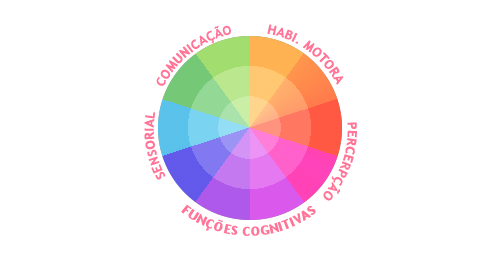
(descrição: círculo com cores similares a um arco íris, amarelo, laranja, vermelho, rosa, lilás, roxo, azul escuro, azul água, verde e verde amarelado. vibrante na beirada mas perdendo cor em direção ao centro. em cinco pontas diferentes estão escritas as palavras: comunicação, habilidade motora, percepção, funções cognitivas e sensorial.)
Dependendo da severidade nessas áreas, você é classificado entre os três níveis de suporte. Ainda sim tenha em mente que as dificuldades variam de autista para autista, aqui vou dar como exemplo:

No gráfico, a maior dificuldade é com funções cognitivas e a menor, agora, são crises sensoriais. Com outro autista pode ser completamente diferente.

NÍVEL 1 & SINDROME DE ASPERGER.
aviso de gatilhos: capacitismo, nazismo, abuso médico.
A síndrome de asperger foi nomeada após as descobertas do psiquiatra nazista, Hans Asperger, se tornarem populares. Ele foi responsável por analisar e executar diversos estudos durante a segunda guerra mundial, além de causar a morte de diversas crianças que não se aliavam aos ideais nazistas ou foram consideradas anormais, incluindo autistas. Por muitos anos, foi retratada como herói da causa e uma das figuras mais importantes nos estudos sobre o autismo pela falta de informação sobre seus ideais, até o momento que diversas anotações e escritos vieram à tona e revelaram sua (quase) aliança com o partido nazista e relatórios cruéis sobre alguns pacientes, especialmente autistas. O que ele notou seria classificado hoje como nível 1.
Com a redefinição de diversos termos, a síndrome de asperger e outros entraram na nova definição do autismo, agora conhecida como Transtorno do Espectro Autista. No entanto, não é incomum ver pessoas usando o termo ainda (geralmente se referindo ao passado), principalmente pessoas diagnosticadas. Os motivos variam e o diagnóstico é um ponto muito importante para a vida do autista, por isso peço que respeite caso a pessoa ainda escolha usar o termo.
por enquanto, é isso! algumas coisas já foram abordadas antes no meu mini guia, mas ainda sim, é bom trazer o conteúdo por completo. espero não demorar para finalizar a próxima parte, mas o tema é complexo e sempre acabo precisando revisar e revisitar algumas pesquisas.
em caso de dúvidas, minha inbox está aberta para perguntas e você pode me chamar no chat do meu blog main (@maphiaclue).

fontes / conteúdos interessantes:
understanding the spectrum.
diferença entre doenças, síndromes e transtornos.
hans asperger, médico que deu nome à sindrome, cooperou com nazistas.
por que algumas pessoas defendem que o termo 'asperger' seja abandonado?
o que é neurônio?
entenda as áreas psicomotoras e como estimular cada uma delas na aprendizagem.
psicomotricidade.
habilidades cognitivas.

34 notes
·
View notes
Text
transxuals survival guide—part a
sex vs gender.
oftentimes when filling out applications or writing statistic sheets, i see people putting cismale or cisfemale for their characters gender. here’s something to consider the next time you get the chance to fill out a character sheet.
sex and gender are not the same!
sex is typically categorized as female or male, but there is variation in the biological attributes that comprise sex and how those attributes are expressed.
gender generally refers to the socially constructed roles, behaviours, expressions and identities of women, men, and nonbinary individuals.
the term cis is most often applied to cisgender identities, so saying cis female is a bit of a misnomer. cis (on this side) and trans (across from or beyond) are typically prefixes for gender, not natal sex.
if you changed the prefix for cis female you would get trans female. that would be a trans man. trans (across from or beyond) female. it would be disrespectful to call a trans man (who has not previously indicated they are okay with it) a trans female.
as with all things related to identity, there is some slack. some trans people prefer to be called transexual (especially when medically transitioning), some nonbinary people prefer to be called trans feminine or trans masculine, as woman nor man don’t apply to their identity.
ultimately, a good format for binary people is to use is x woman or x man, filling the x spot with either cis or trans, and leaving a space between their identity.
why you should care.
understanding gender as distinct from sex acknowledges that one's internal sense of self may not align with their biological characteristics, which helps facilitate trans people in asserting their true gender identity, which may be different from their assigned sex.
using trans inclusive language helps to destigmatize the trans community. it fosters a broader understanding that gender identity is not solely determined by biological characteristics. the separation of sex and gender allows for a more nuanced understanding of human experiences and identities.
32 notes
·
View notes
Text

COMO FAZER TEXTOS COLORIDOS/EM DEGRADÊ NO TUMBLR!
[ Como fazer textos coloridos/em degradê no tumblr!]
Faz tempo que queremos fazer um tutorial assim, mas fica uma jogando pra outra e nunca é feito. Então resolvi fazer, de uma vez por todas, uma ask sobre apareceu do buraco negro que é nossa inbox e me fez lembrar do pedido. Eu sei que o tumblr oferece uma seleção de cores, mas elas são fortes e algumas não são boas para leitura (estou falando de você, senhor amarelo); só que o que vou ensinar aqui vai permitir que qualquer letra fique colorida e na cor que estiver no seu coração! Vou ensinar dois jeitos para fazer um texto colorido e personalizado, é uma boa opção para aqueles que gostam de combinar letra + cor do theme.
Antes de começarmos, creio ser importante comentar que apesar de bonito, fontes coloridas/degradê, como as que vou ensinar, não são lidas em alguns leitores de tela - que são utilizados por pessoas com deficiência visual -, segundo esse post, invés de ler as palavras ou frase normalmente, alguns leitores (talvez não todos) vão soletrar letra por letra e pode se tornar difícil entender. Por que estou falando disso? Achei interessante deixar as pessoas cientes! E tem um meio de “melhorar isso”, que é colocando a tradução embaixo sem qualquer fonte, como não uso leitores de tela, infelizmente não sei como funciona, mas é bom ficar informada.
Agora vamos ao nosso tutorial de hoje!

FAZENDO FRASES EM DEGRADÊ!
Você precisa entrar nesse site, porque ele vai te ajudar a fazer um texto com muitas cores! A interface não mostra muito, mas tem o necessário para o que vamos fazer e não, você não precisa entender horrores de HTML para mexer nele, tanto que vou te ensinar o básico, caso deseje adicionar mais cores.
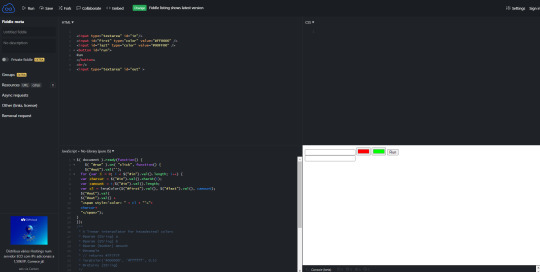
Como pode ver, temos o código e esse quadrado branco, que contém dois retângulos em vermelho e verde. Se você quiser fazer com apenas duas cores, pode pular o que vou ensinar, mas se quiser colocar outras cores, me acompanhe. Digamos que você quer um degradê com quatro cores, mas o código só nos dá duas opções, o que fazer? Simples, veja o print abaixo.

Perceba que aumentei duas linhas entre a “first” e a “last” no código, tanto que notifiquei com as setas vermelhas. Para ter mais opções de cores, você precisa aumentar as linhas, ou seja, como quero quatro cores, adicionei uma linha como “second” e outra como “third” (precisa ser em inglês); só copiar as linhas já existentes, dar um espaço e colar e, claro, mudar os “títulos”. Mas veja que mesmo mexendo no código, continuamos apenas com dois quadrados coloridos e para que o code seja atualizado, você deve apertar no “Run” no menu acima.

Vai atualizar e surgir os quatro campos que desejamos. Eu tentei até dez quadrados de cor e foi, não sei o limite, mas creio que ninguém vai querer um degradê com tantas cores, espero né… Se quiser fazer as cores do arco íris, por exemplo, basta adicionar até o “sixth” e deixar o “last” que vai contar como a sétima cor.


Voltando ao nosso exemplo, com quatro cores, para selecionar as mesmas é só clicar no retângulo e selecionar a cor que desejar. Você pode usar o cursor e ir optando pela cor desejada, mas se você tiver o “code” da cor, só selecionar o “HEX” e colar o código ali. E para chegar no HEX, só clicar duas vezes no “R G B”.

Selecionei essas cores de exemplo e adicionei o texto que desejo, tudo na linha de cima. Não sei se tem limite de caracteres, porque, normalmente, uso apenas para frases pequenas, fica por sua conta em risco tentar. Depois do texto escrito e as cores escolhidas, clique em RUN para que o código apareça na segunda linha (em vermelho no print), você clica ali e dá um ctrl + a e ctrl + c para copiar; agora vamos para o tumblr. Crie uma nova postagem e mude o editor atual para o editor HTML, não vamos mudar de BETA para LEGACY ou vice e versa (nem sei se dá mais). Siga o que indico na imagem abaixo:
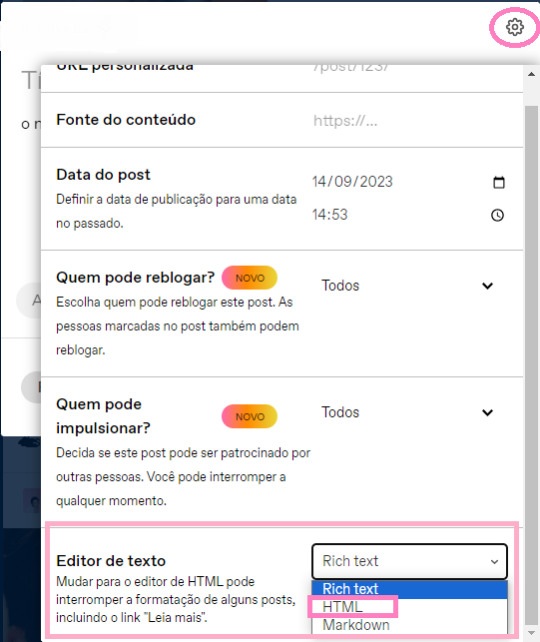
Ao selecionar o editor HTML, nós vamos ter essa interface:

Eu prefiro apagar esse código que aparece, porque dá para editar depois. Depois de apagar, você só precisa colar o código do site ali e antes de salvar, dê uma olhada antes, só mudar de HTML para VISUALIZAR. Se o texto ficou colorido, deu certo! Então pode voltar para o Rich Text de novo e ser feliz. Mas Rinn, eu quero colocar em itálico ou em qualquer formatação do tumblr, como faço? Como faz normalmente com os textos comuns, não vai interferir no degradê.

USANDO APENAS UMA COR!
Você não quer fazer um degradê e não gosta das cores disponibilizadas pelo tumblr, mas ainda quer colocar cores em seu blog? Não tem problema, nós conseguimos também! Você pode usar o site que indiquei, só deixar apenas uma linha ou as duas iniciais, colocando a mesma cor em ambos os retângulos; mas quando quero usar uma cor só, uso um carrd chamado ROLEPLAY FORMATTER! que além de colocar cores, também ajuda a formatar uma resposta para thread - ou para o que quiser.
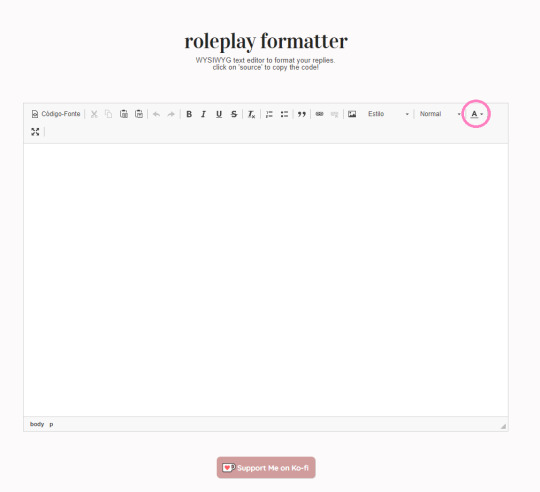
Essa é a interface do formatador, não vou me apegar em como formatar as coisas, se quiserem, posso ensinar depois, hoje vamos falar de cores. Muito simples, você vai clicar onde circulei para aparecer a paleta de cores, infelizmente não temos muitas opções, então só clicar em “Mais Cores” para abrir essa tela.
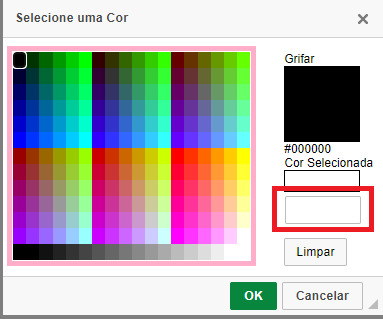
Não tem opção diferente, mas se quiser escolher alguma das colocadas ali, fique à vontade. Normalmente, eu procuro as cores em código em um site que gosto muito. Pesquiso HTML Colors no google e vou no segundo site sugerido, porque acho ele mais fácil de mexer.

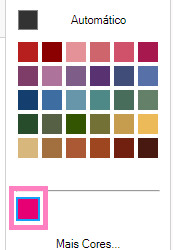
Como na imagem, temos esse hexágono com muitas cores; a cor escolhida e como ela fica em bold e afins + seu código em HEX, RGB e HSL; e por fim, a paleta dessa cor com cores mais claras ou escuras. É dali que você pode tirar a cor que deseja e clicando na mesma, vai aparecer como ela fica nas especificações de bold/italic. Quando encontrar a cor que deseja, copie o código dela e cole no segundo retângulo da aba aberta no carrd de formatar - se não copiou a # junto, não esqueça de colocar na frente - e depois só clicar em ok. A cor fica salva para ser utilizada, então você precisa escrever o que deseja e selecionar tudo para adicionar a cor, fazendo o básico, clicando na opção texto (A) e selecionando a cor escolhida.

Como podem ver, selecionei o texto e depois a cor que queria, se quiser adicionar itálico ou bold, fique a vontade, só usar o que está destacado em rosa claro. Se quiser deixar em small, só clicar onde destaquei em roxo e selecionar a opção. Mas como vamos manter a cor pra colocar no tumblr? Simples, sigam esses passos.
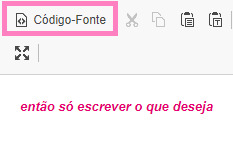

Aperte em “CÓDIGO FONTE” para transformar em HTML, assim vamos ganhar essa “equação” de code, onde: <p> é o começo do código, <i> é o itálico, <b> é o negrito/bold, <small> é para a letra ficar pequena e o <span style=”color: #tantantan”> corresponde a cor que foi selecionada. Dá aquele ctrl + a e ctrl + c esperto e vamos para o tumblr, só repetir o passo referente ao aplicativo no tópico acima e pronto! Agora você tem uma cor diferente na sua dashboard e pode ser feliz.

Acabamos nosso tutorial por aqui e eu espero que tenha sido bom para ajudar alguém, inclusive, esse é o resultado final, em rosa temos o primeiro jeito e em vermelho temos do segundo jeito.

80 notes
·
View notes
Photo

making use of a tl;dr channel to keep everybody in the loop !
given the size of our group, it’s impossible for everyone to know what’s going on at every given time. that would mean having to read through nearly hundreds of threads every single day, and that’s just... unreasonable to expect of anyone.
given this, we created a tl;dr channel at the request of our members ( so we don’t take credit for the idea at all ! ) , where people can submit updates on their muses and what’s been going on with them. here’s a goofy lil example of two updates i sent about my characters:

additionally, your writing partner/s can create threads in response to your update to build on it and add more details as you can see below:
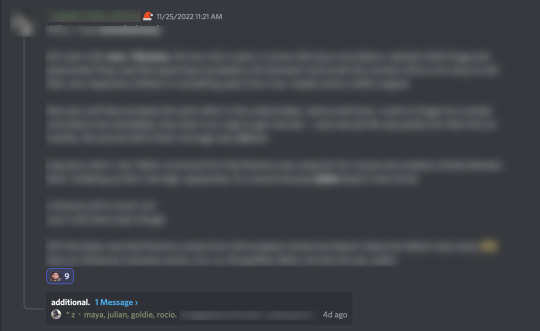
groups that are plot-heavy and very involved might find this useful in keeping everyone in the loop, but i’d say it’s also been incredibly useful for a more plotless rp like ours !
we recommend that our members send in any and all updates that they want people to know, such as when their muses develop a crush or are feeling a certain way about something that’s happened, etc.
you will have to remind people not to meta-game based on what they read in this channel, but that’s kind of a given !
all-in-all, i’ve found that it’s a useful tool in making sure nobody feels left out or in the dark, and it’s always exciting to see what everyone’s muses are up to !
113 notes
·
View notes